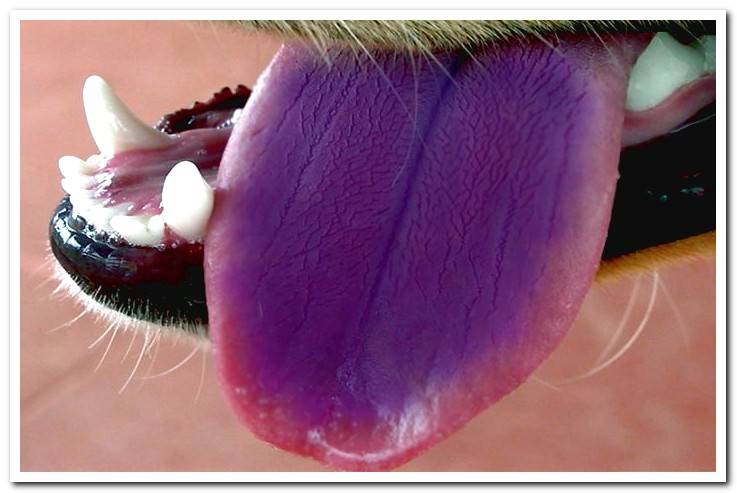
The language of our dog is a very important organ, beyond serving to give us kisses in the form of licks, it can inform us about the state of health of our dog. We must know how to identify what a normal language is like, since changes in its color or shape may be indicative of general illnesses.
The usual color of the tongue is pink in most dogs, but there are some that, without suffering any pathology, have a bluish-purple color. We show you how to identify health problems in your dog through its tongue. Let’s start?
Index of contents
- 1 What is the normal color of a dog’s tongue?
- 2 Is it normal for dogs to have a purple tongue?
- 3 What indicates a color change on the tongue?
- 4 Can diseases be diagnosed through the tongue?
What is the normal color of a dog’s tongue?
In the dog, a healthy tongue is usually bright pink, with a light whitish layer covering its surface, and must not be inflamed, nor have ulcerations, lumps or raised areas.
It is advisable to carry out observations of his tongue as part of the well-being checks that we do at home on our dog. We must look at its color, shape, and make sure there are no ulcers, bleeding, or bumps inside the oral cavity.
We can take advantage to observe the tongue of our dog when it is out of the mouth due to panting after a walk, but in this situation its color will be somewhat more reddish than normal by increasing body temperature. In no case should the tongue be pulled out of the mouth, especially in small breeds.
Is it normal for dogs to have a purple tongue?
Although the normal color of the tongue is pink, some breeds such as Chow chow and their crosses have a bluish-purple color, or some dogs may have areas of dark pigmentation on their tongue like moles, and both cases are within normality and are not related to any pathology.
However, if our dog has a pink tongue and at a certain moment we detect that it has changed to a more bluish-purple color, it is indicative that there may be a respiratory compromise and you are not getting enough oxygen.
For this reason, if we observe a change in the color of our pet’s tongue, we should go to the vet as soon as possible, since it may be undergoing a serious process.

What indicates a color change on the tongue?
As we have seen, a color change in the dog’s league may be indicative of disease. The evident and sudden changes of color, usually indicate important pathological situations.
- Bluetongue: a bluish discoloration of the tongue and mucosa is known as cyanosis and is due to a lack of oxygen in the tissues; It may be secondary to heart or respiratory disease or a drowning situation with obstruction of the airways. So if our dog is not a breed with a naturally bluish tongue and we notice that the mucous membranes of the mouth are also turning blue or purple, it is very important that we urgently go to a vet.
- Purple tongue: If our dog’s tongue turns very dark red or purple and even becomes inflamed, it may be indicative of obstruction of his blood flow. This situation can occur for example if a thread is wound around the tongue and compromises the circulation of the blood. If this situation continues over time, the tissues of the tongue will die and the dog may lose this organ.
- Pale tongue: in animals with anemia or significant blood loss, a pale discoloration of the tongue and gums may be observed. This coloration can also appear in situations in which the dog is subjected to something that is very scary, but if it happens for this reason, the mucous membranes recover their normal coloration as soon as the animal calms down.
- Tongue with dark areas: Flat black pigmented areas on the dog’s tongue and gums are normal. These dark areas are the result of microscopic melanin granules and are not a cause for concern. However, if the dark area is not flat and rises above the surrounding tissues, it is important to see a vet, as it could be melanoma.
Can diseases be diagnosed through the tongue?
According to western medicine, changes in the color of the tongue can give us certain information about the general state of the dog (lack of oxygenation, anemia …), but traditional Chinese medicine goes further, and the inspection and evaluation of the language it is considered one of the most objective diagnostic methods.
For traditional Chinese medicine, the language in general reflects the global state of health of the body and, in addition, some parts of the language reflect the state of health of each organ in particular.
The tip of the tongue reflects the heart, the area between the tip and the center reflects the lungs, the center reflects the stomach and spleen, the root reflects the kidneys, the bladder, and the intestines (and the uterus in females as well) The left edge of the tongue reflects the liver and the right edge the gallbladder. And depending on the color and appearance of each area, the state of the different organs is determined.
The colors of the language can be evaluated according to the principles of traditional Chinese medicine:
- A pale or white tongue may be indicative of a weakened body condition (dogs with anemia, leukemia, blood loss, gastrointestinal problems, lung weakness, malnutrition, etc.)
- A deep red tongue it can indicate hyperactivity of one of the body’s systems (bacterial or viral infection, fever, hyperthyroidism, diabetes, cancer, an accumulation of toxins in some part of the body, etc.)
- A bluish tongue or tinged with purple may be indicative of pain or congestion somewhere in the body (problem with the vascular system, heart disease, circulatory problems, respiratory problems, etc.)
- A orange-yellow tongue It may indicate gastritis and liver or gallbladder malfunction.
As we can see, by observing our dog’s tongue we can obtain a lot of information about its health, so if we perceive that our pet’s language is changing in shape, color or texture, or if we notice any bulging, we should go to a vet to rule out the existence of pathological processes.
